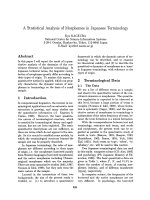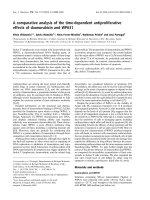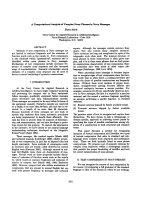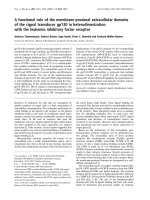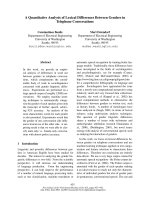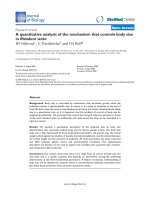Báo cáo y học: "A cross-sectional analysis of video games and attention deficit hyperactivity disorder symptoms in adolescents" pps
Bạn đang xem bản rút gọn của tài liệu. Xem và tải ngay bản đầy đủ của tài liệu tại đây (266.39 KB, 10 trang )
BioMed Central
Page 1 of 10
(page number not for citation purposes)
Annals of General Psychiatry
Open Access
Primary research
A cross-sectional analysis of video games and attention deficit
hyperactivity disorder symptoms in adolescents
Philip A Chan*
1
and Terry Rabinowitz
2
Address:
1
Department of Internal Medicine, Rhode Island Hospital, Brown University, Providence, RI, 02912, USA and
2
Department of Psychiatry,
Fletcher Allen Healthcare, and the University of Vermont College of Medicine, Burlington, VT, 05401, USA
Email: Philip A Chan* - ; Terry Rabinowitz -
* Corresponding author
Abstract
Background: Excessive use of the Internet has been associated with attention deficit hyperactivity
disorder (ADHD), but the relationship between video games and ADHD symptoms in adolescents
is unknown.
Method: A survey of adolescents and parents (n = 72 adolescents, 72 parents) was performed
assessing daily time spent on the Internet, television, console video games, and Internet video
games, and their association with academic and social functioning. Subjects were high school
students in the ninth and tenth grade. Students were administered a modified Young's Internet
Addiction Scale (YIAS) and asked questions about exercise, grades, work, and school detentions.
Parents were asked to complete the Conners' Parent Rating Scale (CPRS) and answer questions
regarding medical/psychiatric conditions in their child.
Results: There was a significant association between time spent playing games for more than one
hour a day and YIAS (p < 0.001), overall grade point average (p ≤ 0.019), and the "Inattention" and
"ADHD" components of the CPRS (p ≤ 0.001 and p ≤ 0.020, respectively). No significant
association was found between body mass index (BMI), exercise, number of detentions, or the
"Oppositional" and "Hyperactivity" components of CPRS and video game use.
Conclusion: Adolescents who play more than one hour of console or Internet video games may
have more or more intense symptoms of ADHD or inattention than those who do not. Given the
possible negative effects these conditions may have on scholastic performance, the added
consequences of more time spent on video games may also place these individuals at increased risk
for problems in school.
Background
The introduction of the telegraph in the nineteenth cen-
tury ushered in a new era of communication and social
development. Further advances in technology led to the
creation of the telephone, radio, and television. Recently,
the Internet has become the pinnacle of interchange in the
modern world and facilitates many different modes of
communication. Each generation has raised concerns
regarding the negative impact of media on social skills
and personal relationships. The Internet appeals to ado-
lescents for many reasons and has become a social con-
Published: 24 October 2006
Annals of General Psychiatry 2006, 5:16 doi:10.1186/1744-859X-5-16
Received: 21 March 2006
Accepted: 24 October 2006
This article is available from: />© 2006 Chan and Rabinowitz; licensee BioMed Central Ltd.
This is an Open Access article distributed under the terms of the Creative Commons Attribution License ( />),
which permits unrestricted use, distribution, and reproduction in any medium, provided the original work is properly cited.
Annals of General Psychiatry 2006, 5:16 />Page 2 of 10
(page number not for citation purposes)
nection for many with uses including messaging, e-mail,
gaming, education, and music.
The Internet and other media types are reported to have
important social and mental health effects in adolescents.
The association between television viewing and obesity,
attention disorders, school performance, and violence has
been reported [1-6]. Likewise, recent studies on obsessive
Internet use called "Internet Addiction" have shown neg-
ative effects on social health [7,8]. A significant relation-
ship between Internet use and attention deficit
hyperactivity disorder (ADHD) has also been shown in
elementary school children [9]. Other studies have
reported the similarities between computer video game
addiction and pathological gambling or substance
dependence [10-12].
The effect of video games on adolescents is not well char-
acterized despite a growing body of evidence demonstrat-
ing their addictive nature and popularity [13-15]. Indeed,
video game use may exceed that of television use in chil-
dren [16]. In pre-adolescent teenagers, obesity has been
linked to increasing time spent on video games, but other
studies have disputed this finding in different populations
[17-19]. Most studies of mental health and media use did
not specifically examine video games, but included them
as a subset of television or Internet use. One extensively
studied area is the content of video games and their rela-
tionship to subsequent aggressive behavior in children
[14,20-22]. Other case reports have documented associa-
tions between video games and various conditions such as
epilepsy, musculoskeletal disorders, and deep vein throm-
bosis, although the strength of these associations has not
yet been established [23-27].
Despite recent negative attention, some studies have
shown possible positive effects of video games on devel-
opment. One study by Li et al. found a positive associa-
tion between motor development and cognitive behavior
in preschool age children [28]. Other studies have
reported that previous computer game experience
enhances laparoscopic simulator performance in physi-
cians [29]. In addition, video games are more frequently
being used as adjuncts to learning and training in various
settings, including medical education [30,31].
The term "video games" does not always differentiate
between console and Internet/computer video games but
instead, suggests a loose clustering. Console video games
include Nintendo, Sony Playstation, Microsoft Xbox, and
others. Internet video games refer to computer games
played online in a community setting with other players.
Although similar in nature, several important differences
exist. Console games can be played with other people, but
most games are "single player" and are meant to be played
alone. Internet games however, are designed for "multi-
player" use and are played with others online, usually at
distant sites. Console games are less expensive than Inter-
net games, and do not require a computer. The genre of
video games played on the Internet versus console games
also differs in content. Console game themes include
sports, action, strategy, family, puzzle, role-playing
games, and simulation, while video game themes
designed for Internet use are more specific and are mainly
action and strategy. The video game market, regardless of
type, is a multi-billion dollar industry that generally tar-
gets children and adolescents.
The relationship between video games and ADHD is
unknown. The incidence of ADHD continues to rise and
is a significant challenge on medical, financial, and educa-
tional resources [32,33]. ADHD is a complex disorder that
often requires input from the affected child or adolescent,
teachers, parents, and physicians in order to be diagnosed
correctly and treated successfully [34]. The Conners' Par-
ent Rating Scale (CPRS) [35] is the most widely used
instrument to aid in the diagnosis of children with
ADHD. The CRS comprises both a parent and teacher
questionnaire, and includes a number of components
including oppositional behavior, hyperactivity, inatten-
tion, and ADHD.
This study examined the relationship between video game
use and symptoms of ADHD. Other parameters studied
included body mass index (BMI), school grades, work,
detentions, and family situation.
Method
Design and procedures
After receiving IRB approval, subjects were recruited from
a local high school in Vermont. Permission from school
officials was obtained and contact was made with the
guidance office and school teachers. Surveys were distrib-
uted to all 9
th
and 10
th
grade students at the school (n =
221). The survey included sections for students (five
pages) and parents (two pages) to complete independ-
ently, as well as a consent form which needed to be signed
by both the student and parent for participation in the
study. All survey data was anonymous. Surveys were col-
lected (n = 162) through the school Guidance Office.
Eighteen surveys were omitted due to incomplete
responses. The final subject pool comprised 144; 72 each
from parents and students. Original power calculations
were based on a reported 10% prevalence of psychiatric
disorders in the adolescent population and called for a
total of 200 students for a power of 0.80. However, statis-
tically significant results were reached after analysis of 144
completed questionnaires and led us to conclude that the
study could be terminated at that point.
Annals of General Psychiatry 2006, 5:16 />Page 3 of 10
(page number not for citation purposes)
Measures
Time spent playing videos games, watching television, or
using the Internet was assessed using a time scale of less
than one hour, one to two hours, three to four hours, or
greater than four hours. The student survey material
included Young's Internet Addiction Scale, modified for
video game use (YIAS-VG; internal consistency, alpha =
0.82) [36]. This scale was validated in previous studies for
Internet addictive qualities [13,36]. The questions reflect
the negative impact of video games on social functioning
and relationships including excessive video game use,
neglecting work and social life, anticipation, lack of con-
trol, and salience. Parents were surveyed using the Con-
ners' Parent Rating Scale (CPRS; internal consistency, r =
0.57) [35]. The CPRS divides behavior into four catego-
ries: oppositional, hyperactivity, inattention, and ADHD.
Other items included gender, family situation, exercise
per week, detentions in the last month, work, and aca-
demic performance. Family situation was defined as
either living with married parents or living with one par-
ent who was divorced or separated. Academic perform-
ance was assessed by overall grade point average and last
grade earned in both mathematics and English classes
given that these two areas are accepted as core competen-
cies in any high school curriculum.
Data analysis
The dependent variables reported in numerical format
(BMI, grades, YIAS-VG, CPRS) were analyzed using the
student's t-test and the Mann-Whitney test. The latter
method is based on median values and is the preferred
method when testing small sample sizes. Data reported as
"yes/no" (sex, work, detentions, exercise, and family situ-
ation) was analyzed using the chi-square test. Results were
considered significant if p ≤ 0.05. Time spent playing
video games, watching television, and using the internet
was the independent variable. The time intervals com-
pared were for student who spent less than one hour or
greater than one hour on a particular activity. The one
hour cutoff was used because it gave a more even distribu-
tion of sample sizes between the two groups although
other time intervals were also compared.
Results
The study cohort comprised 72 students; 31 males and 41
females in the ninth and tenth grade. Average age was 15.3
± 0.7 years. Subject demographics are shown in Table 1.
Almost 32% of students worked and 89% had parents
who were married. Ten students had at least one deten-
tion in the last month and two students were involved in
a physical fight in the last year. Four students consumed
alcohol and one student reported daily smoking. Two stu-
dents reported a diagnosis of ADHD and four reported
having depression and/or anxiety.
The mean BMI for adolescents who watched less than one
hour of television per day was 20.28 ± 2.33 and 22.11 ±
4.01 for those who watched more than one hour of televi-
sion (p = 0.017, Table 2). There was a trend towards a
higher BMI for adolescents spending more than one hour
playing video games, but these results were not signifi-
cant. No association was found between BMI and time
spent on the Internet.
Table 1: Subject Demographics
Population Characteristics Males (n = 31) Females (n = 41) Total (n = 72)
Students who work 26% (8) 37% (15) 32% (23)
Parents married 87% (27) 90% (37) 89% (64)
Divorced, Separated, other 13% (4) 10% (4) 11% (8)
Detention in the last month 19% (6) 10% (4) 14% (10)
Physical fight in the last year 3% (1) 2% (1) 3% (2)
Drink alcohol weekly 3% (1) 7% (3) 6% (4)
Smoke daily 0% (0) 2% (1) 1% (1)
Diagnosed ADD/ADHD 6% (2) 0% (0) 3% (2)
Diagnosed Depression/Anxiety 3% (1) 7% (3) 6% (4)
Table 2: Body Mass Index
INTERNET TELEVISION CONSOLE VIDEO
GAMES
INTERNET VIDEO
GAMES
< 1 hour ≥ 1 hour < 1 hour ≥ 1 hour < 1 hour ≥ 1 hour < 1 hour ≥ 1 hour
Body Mass
Index
Mean 22.09 21.01 20.28 22.11 21.06 23.77 21.31 22.62
± 4.12 ± 3.15 ± 2.33 ± 4.01 ± 3.13 ± 5.19 ± 3.59 ± 3.73
p-value 0.23 0.017 0.12 0.35
Annals of General Psychiatry 2006, 5:16 />Page 4 of 10
(page number not for citation purposes)
Students who played video games for more than one hour
had significant increases in scores on the YIAS-VG (p <
0.001 for console and Internet video games, Table 3).
Other activities were associated with a trend toward
increased YIAS-VG, but were not significant.
There was a significant increase in inattentive (p ≤ 0.001
for both Internet and console video games) and ADHD (p
= 0.018 and 0.020 for console and Internet games, respec-
tively) behavior in those who played video games for
more than one hour (Table 3). No significant association
was found between the hyperactivity or oppositional
components of the CPRS and video game use. No signifi-
cant relationship was found in any of the four categories
and Internet or television use.
There was a trend toward lower grades in students who
surf the Internet and play video games for more than one
hour, but these results were not significant (Table 4).
However, significantly lower grades were found between
students who play video games for more than one hour
and overall grade point average (GPA, p = 0.019 and
0.009 for console and Internet games, respectively).
Males were significantly more likely than females to spend
greater than one hour a day playing console or internet
video games (p < 0.001 and p = 0.003, respectively).
Twenty males reported playing video games for more than
one hour a day versus only one female adolescent
reported playing internet video games for more than one
hour. There was no significant relationship between gen-
der and time spent watching television or on the Internet.
We also found no significant association between time
spent on any media form and students who worked, had
married parents, received more detentions per month, or
exercised more frequently.
Discussion
ADHD among children and adolescents has been attrib-
uted to both genetic and environmental factors[37]. Of
the media influences, only excessive Internet use has been
reported to be associated with ADHD. The diagnosis of
ADHD relies on input from teachers, parents, and physi-
cians. This study found an increase in ADHD and inatten-
tion symptoms in adolescents who play video games for
more than one hour a day.
The prevalence of ADHD in adolescents is reported to be
4–7% [37,38]. This study found a prevalence of 8.3%
based on a reported diagnosis by a parent. It was not pos-
sible to determine the actual diagnosis of ADHD based
only on the raw scores of the CRPS. More or more severe
symptoms of inattention and ADHD behavior were found
in students who played video games for more than one
hour, but further study is needed to more clearly under-
stand the association between video games and ADHD. It
is unclear whether playing video games for more than one
hour leads to an increase in ADHD symptoms, or whether
adolescents with ADHD symptoms spend more time on
video games.
Table 3: Behavioral Symptoms
INTERNET TELEVISION CONSOLE VIDEO
GAMES
INTERNET VIDEO
GAMES
< 1 hour ≥ 1 hour < 1 hour ≥ 1 hour < 1 hour ≥ 1 hour < 1 hour ≥ 1 hour
Young's Addiction Scale Mean 12.80 14.50 9.70 16.00 10.10 34.30 10.20 38.60
± 11.00 ± 16.40 ± 14.60 ± 13.80 ± 10.70 ± 14.80 ± 10.40 ± 13.40
p-value 0.804 0.040 < 0.001 < 0.001
Conner's Scale: Oppositional Mean 1.77 2.66 2.36 2.23 2.33 2.00 2.33 1.89
± 2.36 ± 2.73 ± 2.08 ± 2.85 ± 2.69 ± 2.05 ± 2.72 ± 1.45
p-value 0.096 0.397 0.917 0.826
Conner's Scale: Inattention Mean 1.29 1.68 1.72 1.40 1.00 4.36 1.16 4.00
± 2.67 ± 2.51 ± 2.62 ± 2.57 ± 1.60 ± 4.59 ± 2.25 ± 3.39
p-value 0.289 0.311 0.001 < 0.001
Conner's Scale: Hyperactivity Mean 1.19 1.49 1.40 1.34 1.39 1.18 1.44 0.78
± 1.14 ± 2.11 ± 1.32 ± 1.96 ± 1.82 ± 1.40 ± 1.79 ± 1.39
p-value 0.901 0.397 0.800 0.142
Conner's Scale: ADHD Mean 3.32 4.88 4.64 3.98 3.59 7.64 3.78 7.22
± 3.75 ± 5.13 ± 4.66 ± 4.64 ± 3.89 ± 6.79 ± 4.26 ± 6.12
p-value 0.115 0.343 0.018 0.020
ADHD = Attention deficit hyperactivity disorder
Annals of General Psychiatry 2006, 5:16 />Page 5 of 10
(page number not for citation purposes)
This study found no association between video games use
and oppositional or aggressive behavior. Previous
research has shown a positive correlation between vio-
lence in video games and aggressive behavior
[4,14,20,21]. It is possible that video games only lead to
this type of behavior in groups prone to violent behavior
or in conjunction with other forms of violence in media.
The power of this study was not designed to detect such
differences, thus no inferences can be made.
The effect of television viewing on BMI has been reported
in several studies [1,2,5,6]. We found a significant associ-
ation between increased BMI and watching television for
more than one hour. Playing video games for more than
one hour was not associated with an increase in BMI. Pre-
vious studies found a significant relationship between
BMI and video games in younger populations [18,19].
Our findings suggest this association may persist into
early adolescence.
Time on the Internet was not associated with increased
BMI; a trend towards decreasing BMI was found in adoles-
cents who use the Internet for more than one hour. Our
findings suggest that current recommendations to limit
television and video game times for children should be
followed [6].
Both console and Internet video games were associated
with an increase in addiction scores as measured by YIAS-
VG. The YIAS-VG assesses the degree to which video
games negatively impact different social factors including
daily activities, relationships, sleep, and daily thoughts.
The increase in YIAS-VG scores imply that playing video
games for more than one hour a day does have a negative
impact on relationships and daily activity. We did not
define a cutoff on the YIAS-VG to identify "excessive"
video game use but the scores in our cohort were not high
enough to be considered as evidence of "Internet Addic-
tion" [13,36].
GPA was lower in those who played video games for more
than one hour. Even though this study cohort had a rela-
tively high overall GPA, the difference between an "A"
(less than one hour of video games) versus a "B" (more
than one hour of video games) is a significant change in
grade. For students who are less academically proficient,
this may be especially important. There was also a trend
towards a lower GPA in students who watch television for
more than one hour. Excessive television has been
reported to be associated with poor school performance
[6].
This investigation found that playing console and Internet
video games for more than one hour a day has negative
social and academic effects in adolescents. This associa-
tion does not depend on being "addicted" to video games
or playing for excessive time periods. Furthermore, there
was no difference between playing video games on the
Internet or on a console system. The intensive nature of
video games is likely to cause this time dependent rela-
tionship between video games and behavior disorders,
regardless of whether it is over the Internet or on a console
system.
Several limitations of the study exist. This cross-sectional
comparison of video games and ADHD does not allow for
cause-effect relationships to be established. Therefore, it is
impossible to say whether playing video games leads to an
increase in ADHD symptoms, or if adolescents with more
ADHD symptoms tend to spend longer times playing
video games. Prospective studies to examine this relation-
ship more closely are certainly justified. The subject
cohort was also not representative of all groups. The large
majority of students who responded to the survey were
Table 4: Academic Performance
INTERNET TELEVISION CONSOLE VIDEO
GAMES
INTERNET VIDEO
GAMES
< 1 hour ≥ 1 hour < 1 hour ≥ 1 hour < 1 hour ≥ 1 hour < 1 hour ≥ 1 hour
Last Grade in Math Mean 3.422 3.308 3.306 3.383 3.393 3.132 3.37 3.259
± 0.689 ± 0.748 ± 0.687 ± 0.744 ± 0.706 ± 0.805 ± 0.705 ± 0.863
p-value 0.547 0.422 0.255 0.754
Last Grade in English Mean 3.263 3.201 3.217 3.232 3.254 3.067 3.267 2.963
± 0.721 ± 0.662 ± 0.608 ± 0.723 ± 0.659 ± 0.829 ± 0.638 ± 0.934
p-value 0.545 0.727 0.545 0.395
Overall Grade Point Average Mean 3.686 3.523 3.626 3.567 3.668 3.002 3.668 3.00
± 0.392 ± 0.494 ± 0.438 ± 0.475 ± 0.341 ± 0.762 ± 0.356 ± 0.701
p-value 0.190 0.735 0.019 0.009
Annals of General Psychiatry 2006, 5:16 />Page 6 of 10
(page number not for citation purposes)
Table 5: UNIVERSITY OF VERMONT STUDENT SURVEY (To be completed individually by student)
Age: Height: Weight:
Sex: (Circle one) Male Female
Occupation: Year in School: Type of work (if any):
Last grade in Math Class (as appears on last report card): A+ A A- B+ B B- C+ C C- D+ D D- F
Last grade in English Class (as appears on last report card): A+ A A- B+ B B- C+ C C- D+ D D- F
Overall average grade (as appears on last report card):
How often do you exercise in an average week? (Circle one) Every day 4–6 days a week 1–3 days a week Less than one day a
week
What is your family situation: Parents are married or live together Parents live apart Parents are divorced, I live
with mom or dad
Live with legal guardian
Average total number of hours a day spent on Internet: (Circle one) Less than 1 1–2 3–4 More than 4
Average total number of hours a day spent on Computer games: (Circle one) Less than 1 1–2 3–4 More than 4
Average total number of hours a day spent on other console games such as
Playstation, N64, etc. (Circle one)
Less than 1 1–2 3–4 More than 4
Total number of hours a day spent watching television: (Circle one) Less than 1 1–2 3–4 More than 4
Type of games played : (Circle as many as apply) Sports Strategy Action Other
Favorite game:
How many detentions have you had in the past month?
Have you been suspended from school in the past year? YES NO If yes, how many times?
Have you been in a physical fight in the past year? YES NO If yes, how many times?
Have you been arrested in the past year? YES NO If yes, how many times?
Do you drink alcohol? (Circle one) YES NO
If yes, how many drinks per week on average?
Do you smoke? (Circle one) YES NO
If yes, how many cigarettes per day on average?
Do you smoke marijuana? (Circle one) YES NO
If yes, how many joints per week on average?
Other drugs and amount:
How often do you use alcohol/cigarettes/drugs while playing video games? (Circle
one)
ALWAYS SOMETIMES RARELY NEVER
Rarely Occasionally Frequently Often Always Does Not
Apply
1. How often do you find that you play video games longer than you intended?
2. How often do you neglect household chores to spend more time playing video
games?
Annals of General Psychiatry 2006, 5:16 />Page 7 of 10
(page number not for citation purposes)
3. How often do you prefer the excitement of playing video games to spending time
with your girl/boy friend or family?
4. How often do you play video games with friends?
5. How often do others in your life complain to you about the amount of time you
spend playing video games?
6. How often do your grades or schoolwork suffer because of the amount of time
you spend playing video games?
7. How often do you play video games before something else that you need to do?
8. How often does your job performance or productivity suffer because of playing
video games?
9. How often do you become defensive or secretive when anyone asks you how
much time you spend playing video games?
10. How often do you block out disturbing thoughts about your life with thoughts of
playing video games?
11. How often do you find yourself anticipating when you will play video games
again?
12. How often do you fear that life without video games would be boring, empty,
and joyless?
13. How often do you snap, yell, or act annoyed if someone bothers you while you
are playing video games?
14. How often do you lose sleep due to late-night video games?
15. How often do you feel preoccupied with playing video games when not, or
fantasize about doing so?
16. How often do you find yourself saying "just a few more minutes" when playing
video games?
17. How often do you try to cut down the amount of time you spend playing video
games and fail?
18. How often do you try to hide how long you've been playing video games?
19. How often do you choose to spend more time playing video games over going
out with others?
20. How often do you feel depressed, moody, or nervous when you are not playing
video games, which goes away once you are back playing?
Subjects were also asked to complete the Beck Depression Inventory.
Production note: This article was amended post-publication. For copyright reasons, the Beck Depression Inventory was removed.
Thank you for taking part in our survey. All results are confidential. Please contact Philip Chan (research coordinator) at anytime with questions.
PLEASE PLACE FINISHED SURVEY IN A SEALED ENVELOPE
Table 5: UNIVERSITY OF VERMONT STUDENT SURVEY (To be completed individually by student) (Continued)
Annals of General Psychiatry 2006, 5:16 />Page 8 of 10
(page number not for citation purposes)
Table 6: UNIVERSITY OF VERMONT PARENT SURVEY (To be completed by the parent/guardian who is most involved in the
student's care/daily life)
Relation to student: (Circle one) Father Mother Legal Guardian Other (specify):
Number of hours child spends a day on
Internet total: (Circle one)
< 1 1–2 3–4 >4
Number of hours a day child spends on
computer games: (Circle one)
< 1 1–2 3–4 >4
Number hours a day child spends on
console games (Playstation, Nintendo,
etc.): (Circle one)
< 1 1–2 3–4 >4
Number hours a day child spends
watching television: (Circle one)
< 1 1–2 3–4 >4
Has your son/daughter ever been
diagnosed with: (Circle one)
Depression Anxiety Disorder ADD/ADHD Other (specify):
If so, for how many years?
Does your son/daughter have any other
medical illnesses (diabetes, epilepsy, etc.)?
Yes No If so, please specify:
Is your son/daughter currently on any
prescription medications?
Yes No
If so, please list medications:
Is your son/daughter: NOT TRUE AT ALL
(NEVER, SELDOM)
JUST A LITTLE TRUE
(SOMETIMES)
PRETTY MUCH TRUE
(OFTEN)
VERY MUCH TRUE
(VERY OFTEN)
1 Inattentive, easily distracted
2 Angry and resentful
3 Difficulty doing or completing
homework
4 Always "on the go"
5 Short attention span
6 Argues with adults
7 Fidgets with hands/feet, squirm in seat
8 Fails to complete assignments on time
9 Hard to control in malls or grocery
shopping
10 Messy or disorganized at home or
school
11 Loses temper
12 Needs close supervision to get through
assignments
13 Only attends if it is something he/she is
very interested in
14 Runs or climbs excessively in situations
where it is inappropriate
15 Distractibility or attention span a
problem
16 Irritable
17 Avoids, expresses reluctance about, or
has difficulty engaging in tasks that
require sustained mental effort (such as
school work or homework)
18 Restless in the "squirmy" sense
19 Gets distracted when given instruction
to do something
20 Actively defies or refuses to comply
with adults' requests
21 Has trouble concentrating in class
22 has difficulty waiting in lines or
awaiting turn in games or group situations
23 Leaves seat in classroom or other
situation in which remaining seated is
expected
24 Deliberately does things that annoy
other people
25 Does not follow through on
instructions and fails to finish schoolwork,
chores, or duties in the workplace
26 has difficulty playing or engaging in
leisure activities quietly
27 Easily frustrated in efforts
Thank you for taking part in our survey. All results are confidential. Please contact Philip Chan (research coordinator) at any-
time with questions.
PLEASE PLACE FINISHED SURVEY IN A SEALED ENVELOPE
Annals of General Psychiatry 2006, 5:16 />Page 9 of 10
(page number not for citation purposes)
Caucasian, not involved with drugs or alcohol, had mar-
ried parents, and did well in school. Thus, the association
between video games and ADHD in other cohorts cannot
be inferred. This study was designed to analyze adoles-
cents who spent more than one hour of time playing
video games. It would be interesting to examine the latter
cohort in more detail to determine if there is a linear rela-
tionship between time spent playing video games and
ADHD symptoms or academic performance, or if some
other relationship exists among those who spend exces-
sive time on these activities.
Conclusion
To our knowledge, this is the first study to find an associ-
ation between video game use and ADHD symptoms in
adolescents. Assessment of ADHD risk factors often
involves identification of home and academic environ-
mental factors. Parental relationships, early childhood
development factors (i.e. preterm delivery), and excessive
Internet use are associated with ADHD later in life. Iden-
tification of these and other risk factors that contribute to
ADHD will lead to prevention and earlier treatment strat-
egies.
Production note
This article was amended post-publication. The Beck
Depression Inventory was originally listed in Appendix A
(Table 5), but has been removed for copyright reasons.
Acknowledgements
We thank Diantha Howard for statistical assistance and Juliette Chan for
her support. We are grateful to Linda Barnes and Sarah Smith Conroy for
their assistance.
References
1. Hancox RJ, Poulton R: Watching television is associated with
childhood obesity: but is it clinically important? Int J Obes
(Lond) 2005.
2. Marshall SJ, Biddle SJ, Gorely T, Cameron N, Murdey I: Relation-
ships between media use, body fatness and physical activity
in children and youth: a meta-analysis. Int J Obes Relat Metab
Disord 2004, 28(10):1238-1246.
3. Christakis DA, Zimmerman FJ, DiGiuseppe DL, McCarty CA: Early
television exposure and subsequent attentional problems in
children. Pediatrics 2004, 113(4):708-713.
4. Browne KD, Hamilton-Giachritsis C: The influence of violent
media on children and adolescents:a public-health approach.
Lancet 2005, 365(9460):702-710.
5. Eisenmann JC, Bartee RT, Wang MQ: Physical activity, TV view-
ing, and weight in U.S. youth: 1999 Youth Risk Behavior Sur-
vey. Obes Res 2002, 10(5):379-385.
6. Pediatrics AAo: American Academy of Pediatrics: Children,
adolescents, and television. Pediatrics 2001, 107(2):423-426.
7. Shapira NA, Goldsmith TD, Keck PE Jr, Khosla UM, McElroy SL: Psy-
chiatric features of individuals with problematic internet
use. J Affect Disord 2000, 57(1–3):267-272.
8. Shapira NA, Lessig MC, Goldsmith TD, Szabo ST, Lazoritz M, Gold
MS, Stein DJ: Problematic internet use: proposed classification
and diagnostic criteria. Depress Anxiety 2003, 17(4):207-216.
9. Yoo HJ, Cho SC, Ha J, Yune SK, Kim SJ, Hwang J, Chung A, Sung YH,
Lyoo IK: Attention deficit hyperactivity symptoms and inter-
net addiction. Psychiatry Clin Neurosci 2004, 58(5):487-494.
10. Tejeiro Salguero RA, Moran RM: Measuring problem video game
playing in adolescents. Addiction 2002, 97(21):1601-1606.
11. Johansson A, Gotestam KG: Problems with computer games
without monetary reward: similarity to pathological gam-
bling. Psychol Rep 2004,
95(2):641-650.
12. Griffiths MD, Hunt N: Dependence on computer games by ado-
lescents. Psychol Rep 1998, 82(2):475-480.
13. Johansson A, Gotestam KG: Internet addiction: characteristics
of a questionnaire and prevalence in Norwegian youth (12–
18 years). Scand J Psychol 2004, 45(3):223-229.
14. Gentile DA, Lynch PJ, Linder JR, Walsh DA: The effects of violent
video game habits on adolescent hostility, aggressive behav-
iors, and school performance. J Adolesc 2004, 27(1):5-22.
15. Nippold MA, Duthie JK, Larsen J: Literacy as a leisure activity:
free-time preferences of older children and young adoles-
cents. Lang Speech Hear Serv Sch 2005, 36(2):93-102.
16. Christakis DA, Ebel BE, Rivara FP, Zimmerman FJ: Television,
video, and computer game usage in children under 11 years
of age. J Pediatr 2004, 145(5):652-656.
17. Wake M, Hesketh K, Waters E: Television, computer use and
body mass index in Australian primary school children. J Pae-
diatr Child Health 2003, 39(2):130-134.
18. Vandewater EA, Shim MS, Caplovitz AG: Linking obesity and
activity level with children's television and video game use. J
Adolesc 2004, 27(1):71-85.
19. Stettler N, Signer TM, Suter PM: Electronic games and environ-
mental factors associated with childhood obesity in Switzer-
land. Obes Res 2004, 12(6):896-903.
20. Anderson CA: An update on the effects of playing violent
video games. J Adolesc 2004, 27(1):113-122.
21. Anderson CA, Bushman BJ: Effects of violent video games on
aggressive behavior, aggressive cognition, aggressive affect,
physiological arousal, and prosocial behavior: a meta-ana-
lytic review of the scientific literature. Psychol Sci 2001,
12(5):353-359.
22. Haninger K, Thompson KM: Content and ratings of teen-rated
video games. Jama
2004, 291(7):856-865.
23. Vaidya HJ: Playstation thumb. Lancet 2004, 363(9414):1080.
24. Lee H: A new case of fatal pulmonary thromboembolism
associated with prolonged sitting at computer in Korea. Yon-
sei Med J 2004, 45(2):349-351.
25. Kang JW, Kim H, Cho SH, Lee MK, Kim YD, Nan HM, Lee CH: The
association of subjective stress, urinary catecholamine con-
centrations and PC game room use and musculoskeletal dis-
orders of the upper limbs in young male Koreans. J Korean
Med Sci 2003, 18(3):419-424.
26. Kasteleijn-Nolst Trenite DG, da Silva A, Ricci S, Binnie CD, Rubboli
G, Tassinari CA, Segers JP: Video-game epilepsy: a European
study. Epilepsia 1999, 40(Suppl 4):70-74.
27. Kasteleijn-Nolst Trenite DG, Martins da Silva A, Ricci S, Rubboli G,
Tassinari CA, Lopes J, Bettencourt M, Oosting J, Segers JP: Video
games are exciting: a European study of video game-induced
seizures and epilepsy. Epileptic Disord 2002, 4(2):121-128.
28. Li X, Atkins MS: Early childhood computer experience and
cognitive and motor development. Pediatrics 2004,
113(6):1715-1722.
29. Enochsson L, Isaksson B, Tour R, Kjellin A, Hedman L, Wredmark T,
Tsai-Fellander L: Visuospatial skills and computer game expe-
rience influence the performance of virtual endoscopy. J Gas-
trointest Surg 2004, 8(7):876-882. discussion 882.
30. Latessa R, Harman JH Jr, Hardee S, Scmidt-Dalton T: Teaching
medicine using interactive games: development of the
"stumpers" quiz show game. Fam Med 2004, 36(9):616.
31. Rosenberg BH, Landsittel D, Averch TD: Can video games be
used to predict or improve laparoscopic skills? J Endourol 2005,
19(3):372-376.
32. Birnbaum HG, Kessler RC, Lowe SW, Secnik K, Greenberg PE, Leong
SA, Swensen AR: Costs of attention deficit-hyperactivity disor-
der (ADHD) in the US: excess costs of persons with ADHD
and their family members in 2000. Curr Med Res Opin
2005,
21(2):195-206.
33. Swensen AR, Birnbaum HG, Secnik K, Marynchenko M, Greenberg P,
Claxton A: Attention-deficit/hyperactivity disorder: increased
costs for patients and their families. J Am Acad Child Adolesc Psy-
chiatry 2003, 42(12):1415-1423.
34. McGough JJ, McCracken JT: Assessment of attention deficit
hyperactivity disorder: a review of recent literature. Curr
Opin Pediatr 2000, 12(4):319-324.
Publish with BioMed Central and every
scientist can read your work free of charge
"BioMed Central will be the most significant development for
disseminating the results of biomedical research in our lifetime."
Sir Paul Nurse, Cancer Research UK
Your research papers will be:
available free of charge to the entire biomedical community
peer reviewed and published immediately upon acceptance
cited in PubMed and archived on PubMed Central
yours — you keep the copyright
Submit your manuscript here:
/>BioMedcentral
Annals of General Psychiatry 2006, 5:16 />Page 10 of 10
(page number not for citation purposes)
35. Conners CK, Sitarenios G, Parker JD, Epstein JN: The revised Con-
ners' Parent Rating Scale (CPRS-R): factor structure, relia-
bility, and criterion validity. J Abnorm Child Psychol 1998,
26(4):257-268.
36. Widyanto L, McMurran M: The psychometric properties of the
internet addiction test. Cyberpsychol Behav 2004, 7(4):443-450.
37. Hudziak JJ, Derks EM, Althoff RR, Rettew DC, Boomsma DI: The
genetic and environmental contributions to attention deficit
hyperactivity disorder as measured by the conners' rating
scales – revised. Am J Psychiatry 2005, 162(9):1614-1620.
38. Dey AN, Schiller JS, Tai DA: Summary health statistics for U.S.
children: National Health Interview Survey, 2002. Vital Health
Stat 10 2004:1-78.

